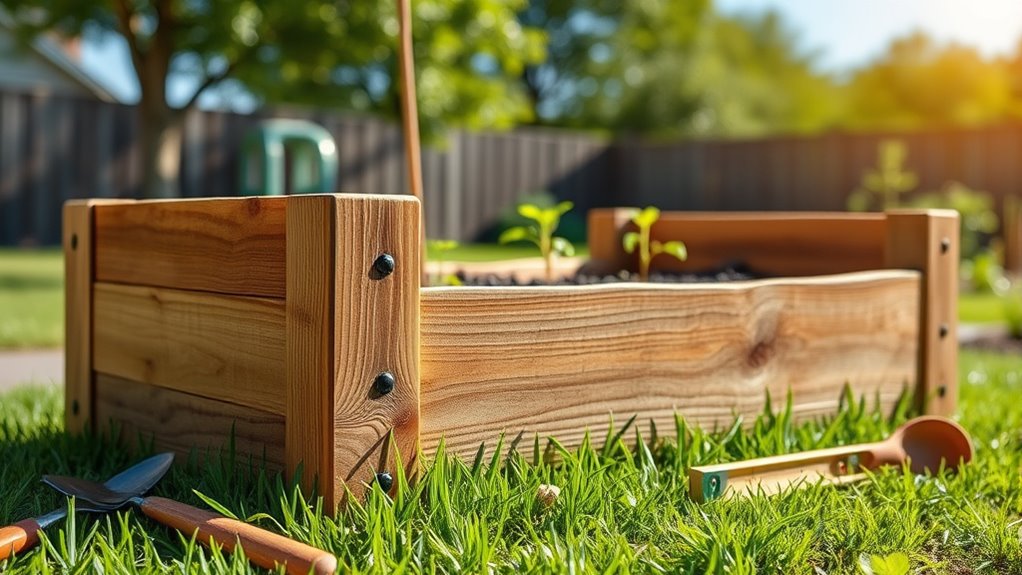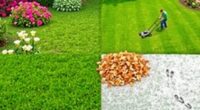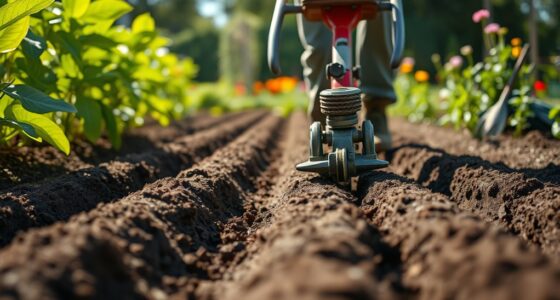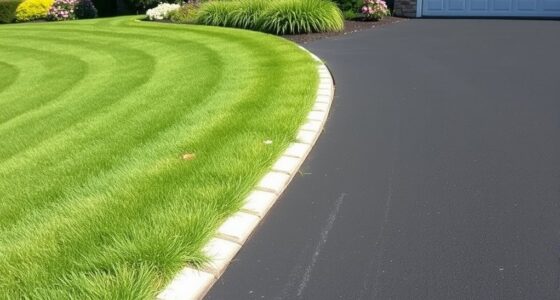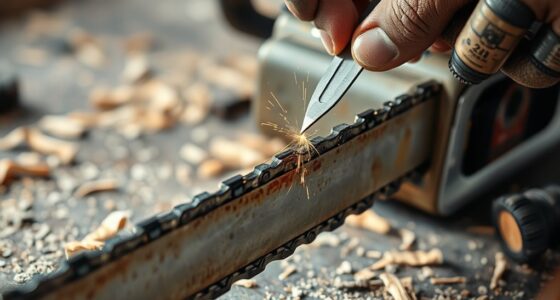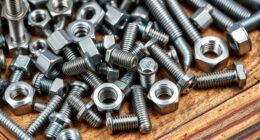To build a raised garden bed, pick a sunny, well-drained location free of shade and weeds. Gather durable lumber, screws, and essential tools, then assemble the frame, ensuring it’s level and sturdy. Fill it with nutrient-rich soil mixed with compost and amendments for proper drainage and plant health. Add mulch, space your plants appropriately, and use companion planting for pest control. If you keep going, you’ll discover all the simple steps to create a thriving garden bed.
Key Takeaways
- Select a flat, well-drained site with ample sunlight and good airflow for optimal plant growth.
- Gather durable lumber, tools, and landscape fabric; assemble the frame securely with level checks.
- Fill the bed with nutrient-rich, well-draining soil mixed with compost and organic amendments.
- Plant vegetables with proper spacing, incorporate companion plants, and add mulch to retain moisture and suppress weeds.
- Maintain the garden through regular pest checks, natural pest control, and ecosystem-friendly practices for healthy growth.
Planning Your Garden Bed Design and Location

Before building your raised garden bed, it’s essential to carefully choose its location and design. Your garden layout impacts plant growth, so pick a spot that offers good airflow and easy access. Sunlight considerations are crucial; most vegetables and flowers need at least six hours of direct sunlight daily. Observe your yard’s sun patterns throughout the day to identify the brightest, sunniest areas. Avoid shaded spots caused by trees, buildings, or fences. Consider the bed’s orientation to maximize sunlight exposure and promote healthy growth. Think about drainage and accessibility as well, ensuring water doesn’t pool and you can tend to your plants comfortably. Planning these factors now will set a solid foundation for a successful, thriving garden. Incorporating wall organization systems can also help keep your gardening tools and supplies neatly stored and accessible nearby.
Gathering Materials and Tools Needed

To build a sturdy raised garden bed, you’ll need to gather all the necessary materials and tools upfront. Start with durable lumber, such as cedar or composite, that enhances garden bed aesthetics and resists rot. You’ll also need screws or nails, a drill or hammer, and a saw to assemble the frame. Consider adding a liner or landscape fabric to improve pest control strategies and prevent weeds. Measuring tape and a level ensure your bed is even and secure. Don’t forget safety gear like gloves and goggles. Gathering these supplies beforehand streamlines the building process and helps you stay focused. With everything on hand, you can efficiently construct your garden bed, creating a beautiful and functional space for your plants.
Preparing the Site for Construction
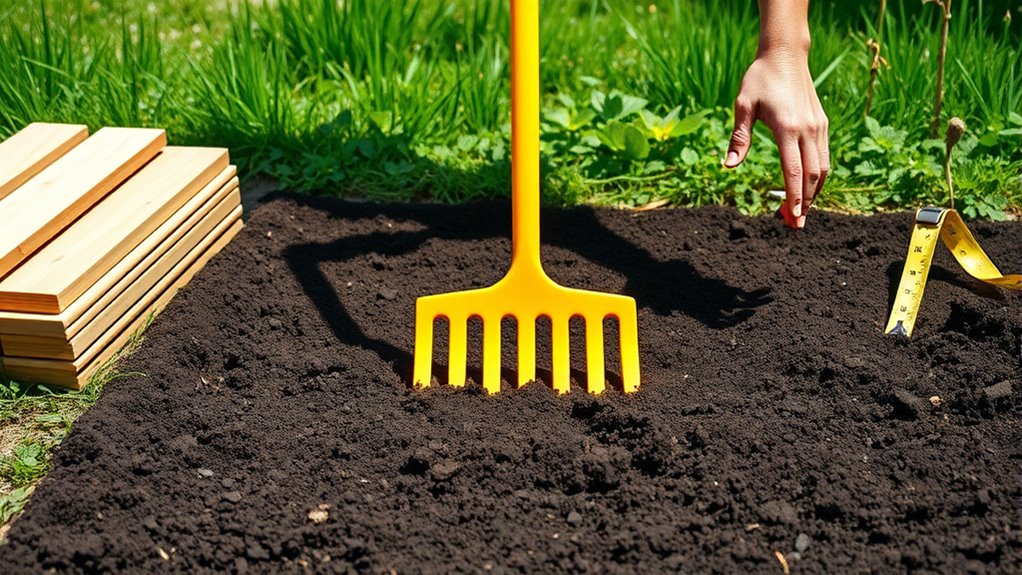
Start by choosing a flat, well-drained location for your garden bed, as this provides a stable foundation and prevents waterlogging. Before construction, perform soil testing to assess nutrient levels and pH balance, ensuring your plants will thrive. If your soil isn’t ideal, consider amending it or replacing it with quality soil. Check the site drainage by observing how water moves after a rain; poor drainage can lead to standing water and root rot. If drainage is an issue, you might need to elevate the site or add gravel beneath the bed to improve water flow. Clearing away weeds, rocks, and debris also prepares the area for building. Properly preparing the site now will save you time and effort later, resulting in a healthier, more productive garden bed. Incorporating drainage solutions can further enhance water management and prevent future issues.
Assembling the Framework of Your Raised Bed

To assemble your raised bed, start by choosing sturdy construction materials that will last through the seasons. Next, gather and connect the frame components carefully to make certain a stable structure. Once assembled, double-check all corners and fastenings to keep your garden bed secure. Additionally, consider the materials used in construction, ensuring they are resistant to moisture and pests for long-term durability.
Choosing Construction Materials
What materials work best for building a sturdy, long-lasting raised bed? Choose options that offer high material durability to withstand weather and soil contact over time. Cedar and redwood are popular because they resist rot naturally, ensuring your bed remains strong for years. Pressure-treated wood is affordable and durable but check for safe, non-toxic treatments to avoid soil contamination. Recycled composite materials are also a good choice—they’re durable and require less maintenance. Beyond durability, consider aesthetic appeal; materials like cedar have a natural, attractive look, blending well with garden surroundings. Digital literacy programs can help seniors learn how to effectively communicate through texting, including humorous exchanges. Whichever material you select, prioritize strength and appearance to build a framework that’s both functional and visually pleasing, ensuring a reliable foundation for your garden’s success.
Assembling Frame Components
Assembling the frame components is a crucial step in building a sturdy raised garden bed. Start by lining up your chosen boards or panels, ensuring they fit together snugly. Secure the corners with screws or brackets, which enhance the structural stability of your bed. Use a level to keep the frame even, as this contributes to both stability and garden bed aesthetics. Proper assembly prevents wobbling and shifting over time, making sure your plants grow on a solid foundation. Double-check all connections before attaching the final pieces. Keep the design simple and neat for improved visual appeal. Additionally, considering ergonomic tools can make the assembly process more comfortable and efficient. By carefully assembling the frame, you create a durable structure that’s both attractive and capable of supporting healthy plant growth.
Filling the Bed With Soil and Amendments
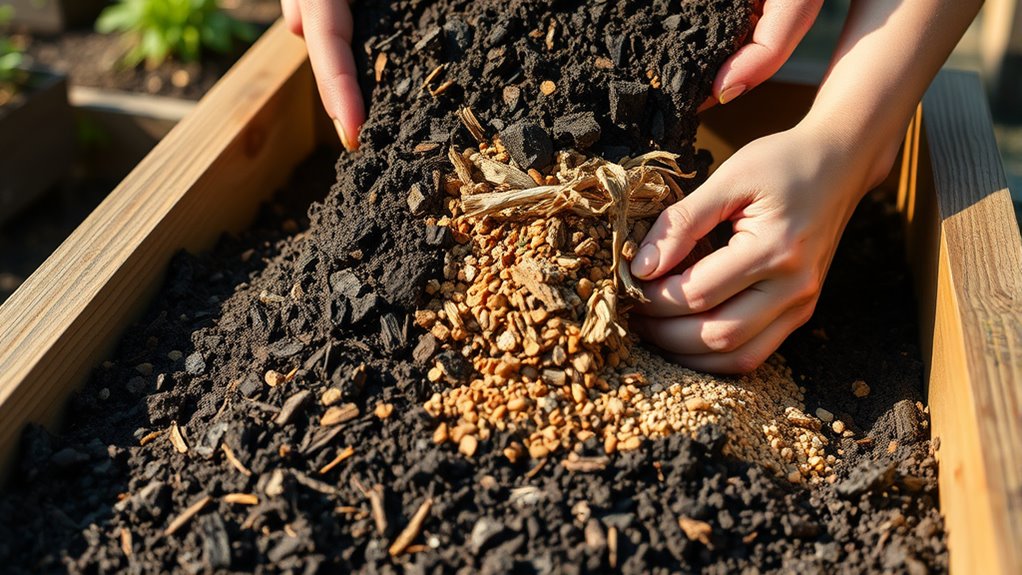
Now it’s time to choose the right soil types for your raised bed and add amendments to improve fertility. You’ll want a mix that drains well but retains moisture, ensuring healthy plant growth. Properly incorporating amendments will give your garden the nutrients it needs to thrive. Understanding your soil’s personality traits can help you select the most compatible soil and amendments for optimal growth.
Choosing Soil Types
Choosing the right soil types is essential for ensuring your raised garden bed provides a healthy environment for your plants. The best soil balances good soil drainage with ample soil nutrients. To envision this:
- You fill the bed with a mix that drains well, preventing waterlogging and root rot.
- The soil is rich in nutrients to support healthy plant growth.
- It retains enough moisture without becoming waterlogged.
- Incorporating a proper contrast ratio in your soil mixture can improve visual cues for moisture retention and aeration.
Opt for a high-quality garden soil or a mix of compost, peat moss, and vermiculite. This combination promotes proper soil drainage while nourishing your plants. Keep in mind that healthy soil encourages strong root systems and vigorous growth, so choose a soil type suited to your specific plants’ needs. Proper soil selection is key to a thriving raised garden bed.
Incorporating Amendments Properly
Before filling your raised bed, it’s important to incorporate amendments properly to guarantee ideal soil health. This ensures good soil aeration and promotes healthy root growth. Mix compost thoroughly into your soil to enrich nutrient content and improve structure. Proper mixing distributes organic matter evenly, enhancing water retention and drainage. A well-prepared bed also benefits from selecting appropriate soil types that suit your planting needs. Visualize the process with this table:
| Layer | Amendment Type | Purpose |
|---|---|---|
| Topsoil | Compost enrichment | Nutrient boost |
| Middle | Coarse sand or gravel | Soil aeration |
| Bottom | Organic matter | Improve drainage and fertility |
Final Touches and Planting Tips

Once you’ve assembled your raised garden bed and filled it with soil, it’s time to focus on final touches and planting tips to guarantee a successful garden. First, consider companion planting; pairing plants like tomatoes with basil can improve flavor and naturally deter pests. Second, add a layer of mulch to retain moisture, suppress weeds, and support healthy growth. Third, when planting, space your vegetables properly to promote airflow and reduce disease risk. Regularly check for pests, and use natural pest control methods to protect your plants. Additionally, practicing mindfulness and presence while tending your garden can enhance your connection to nature and improve your overall gardening experience. By implementing these tips, you’ll create a thriving environment that maximizes your garden’s productivity and minimizes problems. These final touches help assure your garden remains healthy, productive, and pest-free throughout the season.
Frequently Asked Questions
What Are the Best Wood Types for Longevity?
When choosing wood for your garden bed, prioritize durability and natural preservatives. Hardwoods like cedar and redwood stand out because they resist rot and insects naturally, making them ideal for longevity. Pressure-treated wood also lasts longer, but make certain it’s safe for garden use. By selecting these types, you’ll benefit from their inherent natural preservatives and enhanced durability, ensuring your garden bed remains sturdy and beautiful for years to come.
How Deep Should a Raised Garden Bed Be?
You should consider a bed depth of at least 12 inches, ensuring good soil drainage and enough space for roots to grow. Deeper beds, around 18-24 inches, improve soil retention and aeration, but may require more effort and materials. Balancing bed depth considerations helps optimize plant health, water management, and ease of access. Choose the depth that aligns with your gardening goals, space, and the types of plants you want to grow.
Can I Build a Raised Bed on Uneven Ground?
You can definitely build a raised bed on uneven ground. Start by evaluating the terrain and plan for proper soil preparation to guarantee stability. Use shims or adjust the bed height in different areas to level the structure. This way, you create a stable, level planting surface, and your plants will thrive. Just make sure to secure the bed properly and fill it with quality soil for the best results.
How Do I Prevent Pests From Accessing My Garden?
To prevent pests from accessing your garden, you should use natural repellents like neem oil or garlic spray, which deter insects. Additionally, practice companion planting by growing pest-repelling plants like marigolds and basil alongside your vegetables. These methods create a natural barrier, making it harder for pests to reach your plants. Regularly inspect your garden and keep it tidy to further reduce pest hiding spots and guarantee healthy growth.
What Are Eco-Friendly Alternatives to Traditional Soil?
Imagine transforming your garden into an eco-paradise with soil that’s so sustainable, it practically heals itself! Instead of traditional soil, you can use compost alternatives like coconut coir, biochar, or leaf mold. These soil amendment options don’t just nourish your plants—they also reduce waste and lower environmental impact. Embrace these eco-friendly choices, and watch your garden grow greener, healthier, and more resilient than you ever thought possible!
Conclusion
Building a raised garden bed is a rewarding project that can boost your garden’s productivity. Did you know that raised beds can increase yields by up to 25% compared to traditional gardens? By planning carefully, gathering the right materials, and preparing your site, you set yourself up for success. Once filled with nutritious soil and planted with care, you’ll enjoy fresh produce and vibrant blooms all season. Happy gardening!
